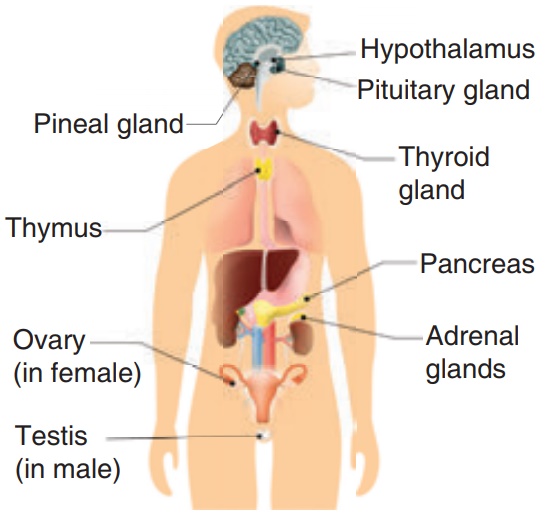Bio-Zoology Laboratory Practical Experiment - Identification of Endocrine Glands | 10th Science : Bio-Zoology Practicals
Chapter: 10th Science : Bio-Zoology Practicals
Identification of Endocrine Glands
IDENTIFICATION OF ENDOCRINE GLANDS
Aim:
To
identify the endocrine gland, its location, hormone secreted and functions -
Thyroid gland and Pancreas
Materials Required:
Endocrine
glands – (a) Thyroid gland (b) Pancreas – Islets of Langerhans
Any one
endocrine gland should be flag labelled.
For the
purpose of flag labelling a model / a chart / photograph showing all endocrine
glands should be used. (Mark the endocrine glands mentioned for the practical)

Identification:
Identify
the flagged endocrine gland, write its location, the hormones secreted and its
functions.
(a) Thyroid gland
Identification:
The flag
labelled endocrine gland is identified as Thyroid gland
Location:
Thyroid
gland is a bilobed gland located in the neck region on either side of the trachea.
Hormones
secreted: Triiodothyronine (T3) and Thyroxine (T4)
Functions of Hormones:
1.
Thyroid hormones increases the basal metabolic rate
(BMR).
2.
It increases the body temperature.
3.
It regulates metabolism
4.
It is required for normal growth and development
5.
It is also known as personality hormone.
6.
Deficiency of thyroxine results in simple goiter,
myxoedema (in adults) and cretinism (in children).
7.
Excess secretion causes Grave’s diseases.
(b) Pancreas – Islets of Langerhans
Identification:
The flag
labelled endocrine gland is identified as Islets of Langerhans in the Pancreas.
Location:
Islets of
Langerhans are seen embedded in the pancreas which is located in the abdominal
region.
Hormones secreted:
1. α
cells secrete glucagon
2. β
cells secrete insulin
Functions of Hormones:
1. Insulin
converts glucose into glycogen and stores it in liver and muscles.
2. Glucagon
converts glycogen into glucose.
3. Insulin
and glucagon maintain the blood sugar level (80 – 120 mg/dl) by their
antagonistic function.
4. Decrease
in insulin secretion causes diabetes mellitus.
Related Topics